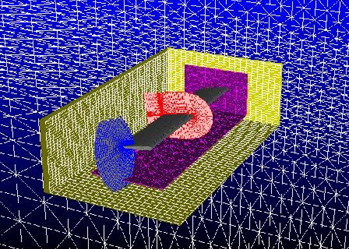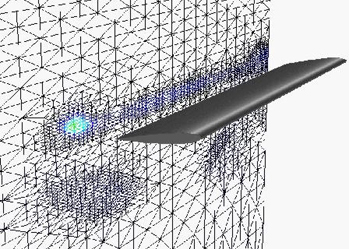ROTOR WAKE CAPTURING WITH STRUCTURED AND UNSTRUCTURED GRIDS
Earl Duque
Roger Strawn
US Army Aeroflightdynamics Directorate
Rupak Biswas
MRJ
NASA Ames Research Center
Moffett Field, CA 94035-1000

Structured grids are used close to the rotor blade and solution-adaptive unstructured grids are used in the far field in order to capture the rotor wake system
Research Objective
Two approaches are typically taken to solve computational fluid dynamics problems with complicated 3-D geometries and flow features. The first uses unstructured solution-adaptive grids. These methods are well suited for solution-adaption to resolve flow features, but grid generation difficulties and large computer memory requirements tend to complicate applications for large 3-D viscous flowfields. The second approach uses a series of overset structured grids to model the flowfield. Each structured grid is usually well formed and implicit time-marching techniques result in computationally-efficient solutions. A problem with this approach, however, is that structured grid methods are not well suited for unsteady grid adaption in three dimensions.
In this work, the advantages of structured and unstructured schemes are combined into a hybrid method that solves the 3-D thin layer Navier-Stokes and Euler equations using overset structured and unstructured grids. This hybrid scheme will be applied to helicopter aerodynamics problems with an emphasis on capturing the vortical rotor wake system.
Approach
A system of overset structured grids is used to resolve the viscous flowfield near the rotor blades while an unstructured grid covers the rotor wake region. Solution quantities are interpolated onto the overlap regions between the structured and unstructured grids as the solution progresses. The unstructured wake grid uses solution-adaption to improve the resolution of the vortical wake system. Various "error" indicators are used to determine where to refine and coarsen the grid for the rotor wake.
Accomplishment Description
The hybrid structure-unstructured flow solver has been implemented for a hovering rotor problem. Computed results showed good agreement with experimental data for blade surface airloads and tip-vortex trajectory. Various error indicators were used to identify locations for grid refinement in the rotor wake with significant differences among the resulting grids. In spite of the enhanced resolution of the rotor wake, further improvements in computational efficiency and computer power are required to accurately model rotor wake systems for helicopter flowfields where blade-vortex interactions are important.

Computational grid and vorticity contours in the near-field behind a rotor blade. Note where grid adaption is used to improve the resolution of the tip vortex and vortex sheet.
Significance
This hybrid solution scheme takes advantage of the capabilities of structured-grid schemes to resolve viscous flows and those of unstructured grid schemes to facilitate solution adaption in the rotor wake. For rotorcraft problems, the resulting computations hold the promise of much higher computational efficiency than either structured or unstructured-grid schemes alone.
Future Plans
Our current approach uses unstructured tetrahedral elements to compute the rotor wake system. However, our results show that tetrahedral elements are not well suited to anisotropic grid refinement. Repeated anisotropic subdivision of tetrahedra result in badly-formed elements with large angles between edges. A better approach is to use hexahedral elements in the rotor wake. Hexahedra can be repeatedly subdivided anisotropically with no loss in element quality. The resulting anisotropic grids in the rotor wake region are much more computationally efficient than their isotropic counterparts for resolving directional flow features. Future applications of the structured-unstructured grid approach will use hexahedral elements in the rotor wake.
Related Publications
Duque, E. P. N., Biswas, R. and Strawn, R. C., "A Solution-Adaptive Structured/Unstructured Overset Grid Flow Solver with Applications to Helicopter Rotor Flows," AIAA paper 95-1766, presented at the AIAA 13th Applied Aerodynamics Conf., San Diego, CA, June 19-21, 1995. (submitted to the AIAA Journal of Aircraft).
Point of Contact
Roger Strawn
NASA Ames Research Center
Moffett Field CA 94035-1000